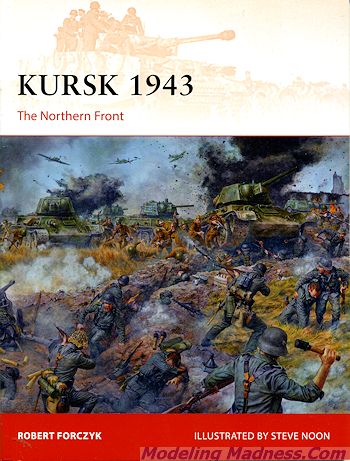Osprey's Kursk 1943
|
Author: |
Robert Forczyk, illustrated by Steve Noon |
|
Publisher/Distributor |
Osprey Publishing |
|
Price |
$21.95 MSRP |
|
Reviewer: |
Scott Van Aken
|
|
Notes: |
96 pages, 7¼ x 9¼ inches, softcover
ISBN:978-1-78200-819-4 |
 Touted
in the past as the 'greatest tank battle of WWII', Kursk was not as many had
thought. Sure, it was an important campaign, but it was not a mass tank battle,
but the usual smaller skirmishes that occurred throughout the war. This
perception is due as much to Soviet propaganda that was repeated and repeated
until many were sure it was truth.
Touted
in the past as the 'greatest tank battle of WWII', Kursk was not as many had
thought. Sure, it was an important campaign, but it was not a mass tank battle,
but the usual smaller skirmishes that occurred throughout the war. This
perception is due as much to Soviet propaganda that was repeated and repeated
until many were sure it was truth.
Kursk was an attempt
by the German Army to use a pincer attack to cut off the Soviets in the Kursk
Salient. However, there were some major situations that caused the German attack
to fail. First off, the Soviets were given intelligence from the British that
the attack was coming. This was because the British had broken the Enigma code,
so no encrypted German message was safe. This allowed the Soviets to build up
their defenses to such a level that they were, in total, nearly impossible to
break through.
Much of this
defense consisted of mine fields of such depth that getting through them was
very time consuming. Indeed, much German armor fell afoul of these mine fields,
further depleting the forces thta the Germans had to put into the campaign. Not
only that, but when the Germans performed a tactical retreat, the first thing
that happened were that the openings in these fields were resown. So skilled
were the Soviet teams, that they were able to produce mine fields mere hours
before German troops and armor reached a specific point. Add to that a
rather great superiority in numbers of tanks, troops and field guns,
combined with defense in depth, and it was pretty certain that the Germans would
fail from the beginning.
However, the Germans were not a push-over
by any means. Soviet commanders were rather inept and the Luftwaffe was able to
not only keep control of the air, but decimated the Soviet Air Armies used
against it. Kursk was also the introduction of the Ferdinand and along with the
Tiger tank, which was impervious to Soviet T-34s and most of their anti-tank
guns, these vehicles helped to make mincemeat out of those Soviet AFVs that came
into their range. However, they were not impervious to mines and thanks to poor
planning regarding spares (as in none), many of these German AFVs were abandon
on the battlefield.
Thanks to the careful planning of German
troops under the command of Model, though unable to attain the objective of
Operation Citadel, the German army was able to hold the line and with a smaller
percentage of losses than has been previously believed.
This was important for soon after
Citadel, the Soviets launched Operation Kutusov in their push to take the
salient around Orel to the north. In this case, they succeeded, though not
without great loss, and mostly due to the depleted condition of the German
forces which they faced. Again, Model was able to pull out of the salient with
minimal losses and to form a defense that the Soviets could not break.
This all makes for an excellent read that
will change a lot of minds about this particular campaign. Robert Forczyk is one
of Osprey's best authors and makes the story of the Kursk battles both
interesting and one that is well researched. A book I can highly recommend to
the enthusiast and historian alike.
October 2014
For more on the complete line of Osprey books,
visit http://ospreygrp.com. In the US, it is
Osprey Direct at 44-02 23rd St, Suite 219, Long Island City, NY 11101., where you can
get a catalogue of available books.
If you would like your product reviewed fairly and fairly quickly, please
contact
the editor or see other details in the
Note to
Contributors.
 Touted
in the past as the 'greatest tank battle of WWII', Kursk was not as many had
thought. Sure, it was an important campaign, but it was not a mass tank battle,
but the usual smaller skirmishes that occurred throughout the war. This
perception is due as much to Soviet propaganda that was repeated and repeated
until many were sure it was truth.
Touted
in the past as the 'greatest tank battle of WWII', Kursk was not as many had
thought. Sure, it was an important campaign, but it was not a mass tank battle,
but the usual smaller skirmishes that occurred throughout the war. This
perception is due as much to Soviet propaganda that was repeated and repeated
until many were sure it was truth.